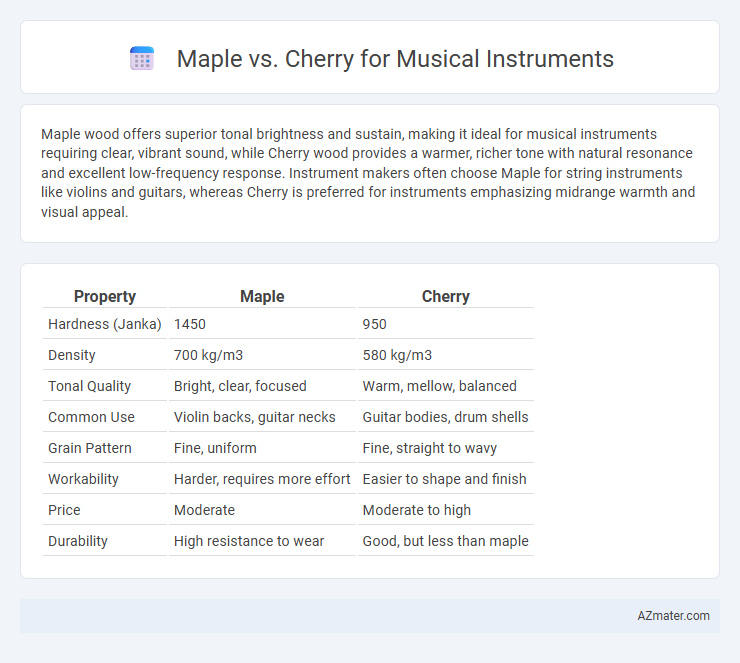Maple wood offers superior tonal brightness and sustain, making it ideal for musical instruments requiring clear, vibrant sound, while Cherry wood provides a warmer, richer tone with natural resonance and excellent low-frequency response. Instrument makers often choose Maple for string instruments like violins and guitars, whereas Cherry is preferred for instruments emphasizing midrange warmth and visual appeal.
Table of Comparison
| Property | Maple | Cherry |
|---|---|---|
| Hardness (Janka) | 1450 | 950 |
| Density | 700 kg/m3 | 580 kg/m3 |
| Tonal Quality | Bright, clear, focused | Warm, mellow, balanced |
| Common Use | Violin backs, guitar necks | Guitar bodies, drum shells |
| Grain Pattern | Fine, uniform | Fine, straight to wavy |
| Workability | Harder, requires more effort | Easier to shape and finish |
| Price | Moderate | Moderate to high |
| Durability | High resistance to wear | Good, but less than maple |
Introduction to Maple and Cherry Wood in Musical Instruments
Maple wood is prized in musical instruments for its tight grain and bright, clear tonal qualities, commonly used in violins, guitars, and drums to enhance projection and sustain. Cherry wood offers a warm, rich tone with a slightly softer resonance, favored in acoustic guitars and woodwind instruments for its smooth sound and attractive reddish hue. Both woods provide durability and aesthetic appeal, influencing the instrument's overall sound quality and visual character.
Physical Properties: Maple vs. Cherry
Maple wood is favored for musical instruments due to its high density, hardness, and excellent stiffness-to-weight ratio, which contribute to bright, clear tones and long sustain. Cherry wood, while softer and less dense than maple, offers a warmer, more resonant sound with moderate durability and a smooth grain that enhances aesthetic appeal. The choice between maple and cherry impacts the instrument's tonal brightness, resonance, and structural stability, making maple ideal for instruments requiring precision and clarity, whereas cherry suits those desiring warmer, mellower sound qualities.
Tonal Qualities: How Maple and Cherry Affect Sound
Maple wood produces bright, clear tones with strong sustain and a tight low end, making it ideal for instruments requiring articulate sound projection like violins and guitars. Cherry wood offers a warmer, mellower tone characterized by a rich midrange and smooth highs, preferred for instruments seeking a more rounded, vintage sound. The dense grain of maple enhances brightness and clarity, while cherry's softer texture contributes to its resonant, balanced tonal quality.
Durability and Longevity in Instruments
Maple wood is highly valued in musical instruments for its exceptional durability and resistance to wear, making it ideal for parts subjected to frequent contact, such as necks and fingerboards. Cherry wood offers moderate durability with a slightly softer surface, which can develop a rich patina over time but may show signs of wear sooner than maple. Instruments crafted from maple generally provide longer-lasting structural integrity and sustain optimal tonal qualities throughout extended use.
Workability and Craftsmanship Considerations
Maple is favored in musical instrument craftsmanship for its exceptional workability, offering smooth carving and shaping, which allows for intricate designs and precise detailing. Cherry wood, while slightly harder to work with, provides a warm tonal quality and fine grain structure that enhances aesthetic appeal but requires careful craftsmanship to avoid splintering. Both woods demand skilled handling, yet maple's consistent density and stability make it particularly suitable for complex instruments like violins and guitars, while cherry is prized for its rich color and resonance in acoustic applications.
Aesthetic Appeal: Grain, Color, and Finish
Maple offers a bright, tight grain with a smooth, reflective finish ideal for creating visually striking musical instruments, often featuring flame or birdseye patterns prized for their elegance. Cherry wood displays a warm, reddish-brown hue that deepens over time, with a fine, even grain providing a rich, vintage aesthetic favored for classical and acoustic instruments. Both woods respond well to various finishing techniques, but maple's high contrast grain typically stands out more in polished, high-gloss finishes, while cherry's softer texture lends itself to satin or oil finishes that highlight its natural warmth.
Popular Instruments Made with Maple and Cherry
Maple is widely favored for its bright tone and strong grain, commonly used in violins, electric guitar necks, and drum shells to enhance sound projection and durability. Cherry wood, known for its warm tonal quality and smooth texture, is often chosen for acoustic guitars and woodwind instruments, providing rich resonance and a balanced midrange. Both woods are essential in lutherie, with maple offering structural stability and cherry delivering aesthetic appeal alongside tonal warmth.
Cost and Availability Comparison
Maple is generally more expensive than cherry wood due to its higher demand in musical instrument manufacturing, especially for guitars and violins. Cherry wood is more readily available and less costly, making it a budget-friendly option for instrument makers without sacrificing tonal quality. Both woods offer distinct sound characteristics, but the cost and accessibility often make cherry a preferred choice for affordable instruments.
Sustainability and Environmental Impact
Maple and cherry woods differ significantly in sustainability and environmental impact for musical instruments. Maple, often sourced from managed forests in North America and Europe, benefits from established reforestation programs that help maintain ecological balance, while cherry wood, predominantly harvested from wild or less-regulated sources, faces higher risks of unsustainable logging. Choosing certified maple with FSC or PEFC labels supports responsible forestry and reduces habitat disruption compared to cherry wood, which may contribute to greater environmental degradation when sourced unsustainably.
Choosing the Right Wood for Your Instrument
Maple offers a bright, clear tone with excellent sustain, making it ideal for instruments like violins and guitars that require precise sound projection. Cherry wood provides a warmer, richer tone with a smooth midrange, favored for instruments seeking a softer, more balanced sound. Selecting between maple and cherry depends on desired tonal qualities and the instrument's role, with maple emphasizing clarity and cherry emphasizing warmth.

Infographic: Maple vs Cherry for Musical Instrument
 azmater.com
azmater.com